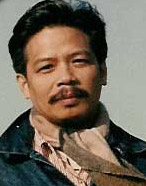 |
||
|---|---|---|
| CP Foundation | About CP Biennale | 2003 | 2005 | Contact Us | >||
           
|
||
|
After working on paintings for some time, Modesto apparently longed to go back creating installation works. He has actually accomplished that for this open biennale, where he displays his installation work called 'Paris Matches'. Like most of Modesto's other installation works that commonly use the same component by the thousands, 'Paris Matches' is arranged using thousands of matches in a transparent box. Unlike his paintings that reveal more of his personal sides, Modesto's installation works are more extroverted and tell of the myriad problems of human beings. This is obvious in 'Paris Matches'. The title is clearly a play on the name of the well-known magazine, 'Paris Match'. The relation between the title of the work and the composition of the work itself suggests the meaning that the artist has intended. The destructive power of matches can naturally not be compared with the destructive power of cutting-edge war machinery. However, people use matches to create fire, and even a small fire has the potential to become bigger and destroy things. Similar thing can be said about the nurtured hatred that can turn into a destructive rage, or a terror of sorts. Still there are other meanings to be read in his works, as Modesto himself believes. He says that "fire and heat and destruction nestled inside each matchbox also contain within them a message of cleansing, renewal, and hope." This is interesting to note, as such meaning is prevalent in the Eastern wisdom. That is why the East always has a god who destroys, and whose position is equal to that of the god who builds. In today's world, the audience will apparently find it easy to read Modesto's work as a symbol of the human capability to hate and destroy. Asmudjo Jono Irianto Born in Quezon City, Phillipines. SELECTED SOLO EXHIBITIONS |
||
|
CP Foundation | About CP Biennale | 2003 | 2005 | Contact Us
Jl. Suryopranoto 67A, Jakarta 10160, Indonesia. ph. +62.21.3448126, 3853206 | fax. +62.21.3853203, 3853208 info@cp-foundation.org |
||
 Fernando Modesto's works are mainly paintings, and most of them portray the universe, often with a depiction of an angel as the main figure. Modesto has been creating many of such allegorical paintings since late 1980s. He has often displayed his works in various solo exhibitions. Aside from painting, Fernando has also been creating experimental and installation works. He is actually one of the first experimental artists in the Philippines. His early works in 1970s were quite radical for that time. One example was his installation work displaying Xerox images from Mona Lisa adorned with blood drips while thousands of bananas were scattered all over the gallery. The work intentionally disturbed its audience, provocatively asked the audience to 'eat and enjoy art.' Meanwhile, his first solo exhibition used marbles as its main component. Modesto scattered thousands of marbles on the gallery floor so that his audience could step on them, kick them, and arranged the marbles as they liked. About this particular exhibition, Modesto said that he was 'sending the message that no man is an island, that whatever action is done by one person will cause another reaction and will affect everyone.'
Fernando Modesto's works are mainly paintings, and most of them portray the universe, often with a depiction of an angel as the main figure. Modesto has been creating many of such allegorical paintings since late 1980s. He has often displayed his works in various solo exhibitions. Aside from painting, Fernando has also been creating experimental and installation works. He is actually one of the first experimental artists in the Philippines. His early works in 1970s were quite radical for that time. One example was his installation work displaying Xerox images from Mona Lisa adorned with blood drips while thousands of bananas were scattered all over the gallery. The work intentionally disturbed its audience, provocatively asked the audience to 'eat and enjoy art.' Meanwhile, his first solo exhibition used marbles as its main component. Modesto scattered thousands of marbles on the gallery floor so that his audience could step on them, kick them, and arranged the marbles as they liked. About this particular exhibition, Modesto said that he was 'sending the message that no man is an island, that whatever action is done by one person will cause another reaction and will affect everyone.'